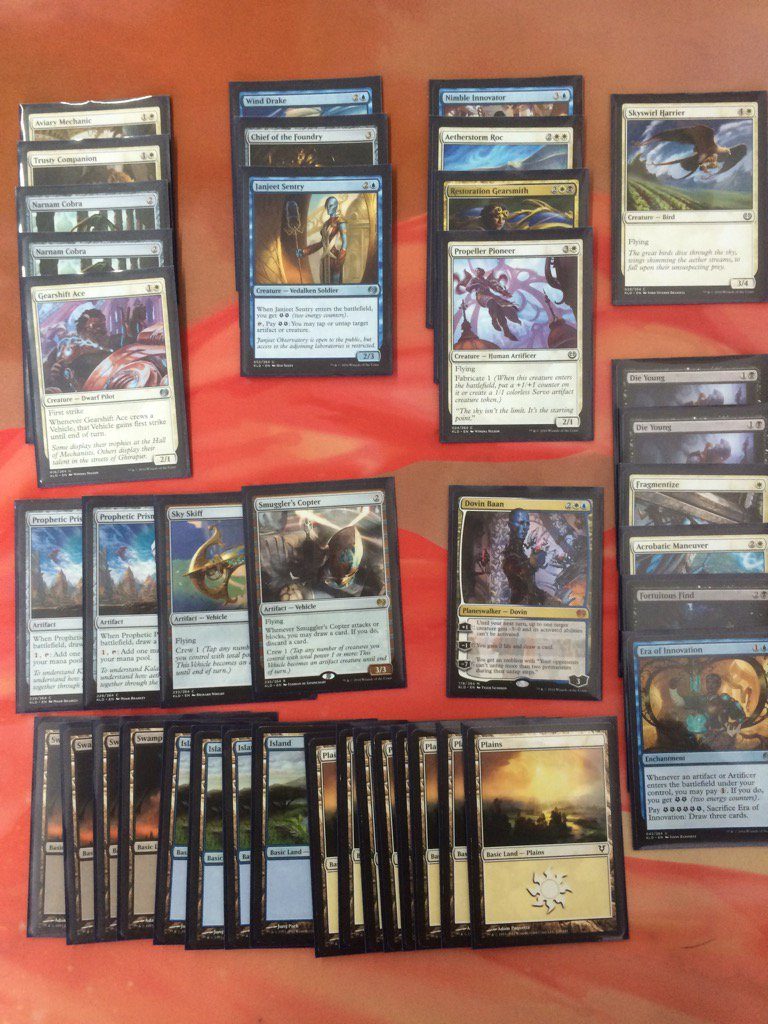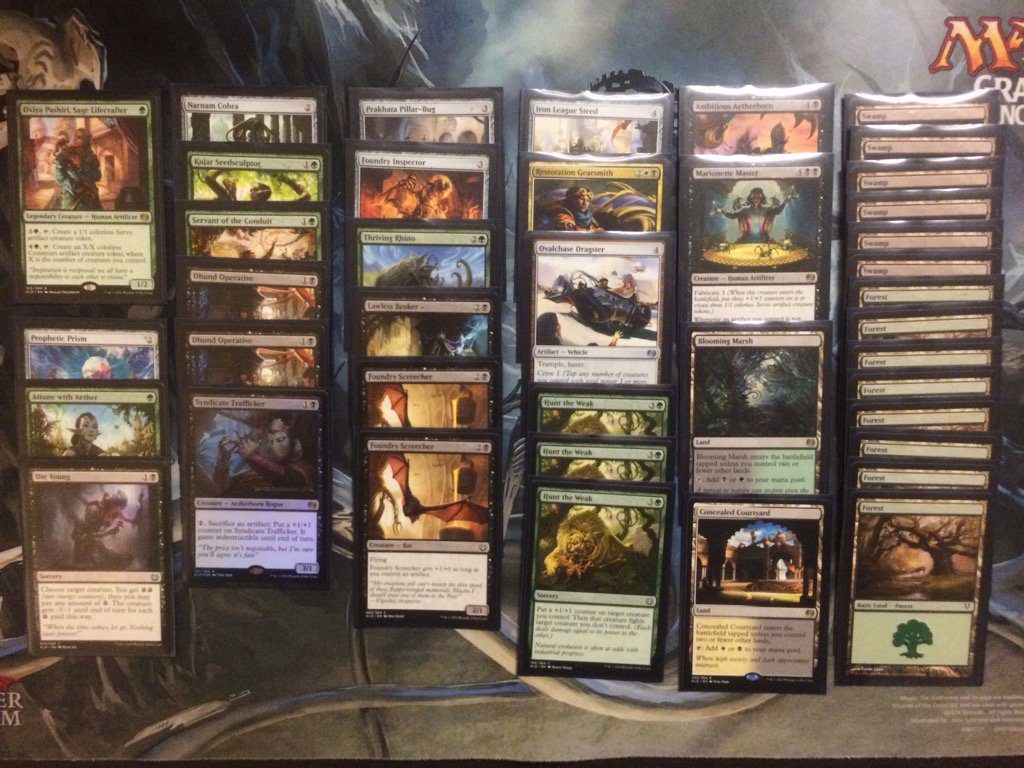Boom goes the prerelease. Kaladesh is fire! I hit up two local prereleases, at I Want More Comics ands Black Gold. This new sealed format is a revelation, and a total change of pace from the last year of sealed play. We desperately needed that. Shadows block definitely suited my style, but I’m ready for the bold new energy world.
And bold it is! Energy feels like caffeine added to a game of Magic. This format goes to eleven. Games are fast and lively. Blocking is difficult. Grinding a slow victory feels precarious. I think you can play to the late game, but you have to be doing stuff every turn. The defining question of each sealed format is this: do you need to play a two drop on curve? Kaladesh says hell yes!
I had a feeling this might be the case going into my first prerelease on Saturday, but I didn’t really build with it in mind. I did what most of us do the first time we open cards from a sweet new set: I jammed the sweetest rares into a deck and went to work. Turns out I opened Dovin Baan, Aetherstorm Roc, Smuggler’s Copter, and Gonti, Lord of Luxury. I ended up playing this:
It turns out this deck is horribly underpowered. People attack with three and four powered creatures early and often, with tricks and various forms of evasion. I simply was unable to build a meaningful board presence. Blocking was always a disaster, even if they didn’t have tricks to blow me out. I had two copies of Select for Inspection that it turns out should have been in the deck. Dovin Baan was mostly useless and felt impossible to protect. I never untapped with him still on board, and often I’d keep an opening hand with him and hate that I did by turn three. And that’s not even a mana greediness issue—I just couldn’t ever keep up on board presence.
Aetherstorm Roc was not useful in this deck, but it’s still a great card. It feels like an amazing curve topper if you already have six power on board before you play it. In my deck, it was the only creature that could hope to get up to four power. I felt like I was playing an infect deck, but had to get to twenty poison instead of ten.
Wind Drake was abysmal, which was a shock. I mean, how can a 2/2 flier be bad in sealed? Honestly, it’s exciting to play a format where efficient evasive threats are bad. Brave new world! I hated that deck so much, I switched into a mediocre red-black aggro deck for the final two rounds of the prerelease. Gonti, Lord of Luxury was amazing, including stealing my final opponent’s masterpiece Sword of Fire and Ice in both games.
That first event gave me a lot to think about. Kaladesh feels invigorating and fresh. I hadn’t been planning to go back for another prerelease on Sunday, but by the time I woke up that morning I knew I had to. I was formulating new principles for deck building and I had to go test them out. Here’s what my second deck looked like:
I sailed to a 4-0 record, dropping only a single game where I drew ten lands. My guiding principle for this deck was attack for three with cheap creatures. Dhund Operative and Foundry Screecher do that quite well, and Syndicate Trafficker was a total house. It also combines nicely with Marionette Master, although I never had the chance to go off with them. The master is quite the margarita, too. If you can drop it in either mode after getting your opponent down around five life, they will have to kill it or lose.
Sixteen lands and a Prophetic Prism will be a common mana base. I was fortunate to pull a couple dual lands and the amazing Servant of the Conduit to help splash Restoration Gearsmith, a card I absolutely love. Oviya was a nice addition for longer games, and helped me grind out a victory over a powerful energy control deck.
Based on my experience at the prerelease, here are my tips for success in Kaladesh limited. They hold for sealed and I expect they will be even more true for draft.
- You want to attack. The set is full of cheap, efficient creatures with a lot of power, across all rarities. Curve out! Take advantage of them by turning them sideways and forcing your opponent to react. Your deck should be filled with two and three drops.
- Tempo matters. Energy is a new resource that lets you generate additional effects without spending mana. This means each turn can be more powerful, and you must maximize each of your turns. Games take fewer turns, so each turn is more important.
- Build a board presence that your opponent cannot handle. Force them to chump block or walk into your tricks. Play tricks and other spells that leverage your attack step, when you have all mana available. Force your opponent to tap out each turn just to chase parity on board.
- Do not play creatures with less power than converted mana cost unless you have a good reason. You want to deal maximum damage to your opponent and their blocking creatures.
- Blocking is worse than attacking. This means 3/2s are better than 2/3s. Creatures that give up points of power for evasion are worse because blocking happens less.
- Evasion that comes with high power, like trample and menace, is better than flying, which comes with low power. An unblockable finisher is more reliable than a random flier if the game goes long, but you should attack and force trades to keep the board uncluttered.
- Servo tokens can get out of hand if you sit back. The key to beating them is to apply so much pressure that your opponent cannot afford to build them up.
- Cards with drawbacks outside of attacking are better than they look. Long-Finned Skywhale isn’t going to block anyway, and it’s one of the few fliers than can race ground creatures.
- Cheap interaction with combat is essential. Kaladesh has many one-mana tricks that allow you to win combat while developing your board after attacking. Select for Inspection only bounces tapped creatures, but it is great protection when you have to block. Bouncing an attacker after a combat trick is one way a defensive deck can stay alive.
- If you aren’t going to win in the first six turns, you probably need a way to gain life. It’s no accident that the white wrath of the set, Fumigate, gains a life for each creature it destroys. You will take damage early in games of Kaladesh limited. Padding your life total is an essential survival tactic.
- Vehicles contribute to the difficulty of stablizing as the control deck. Your opponents will be able to attack much more often than you’d like. If they can resolve a creature with sufficient power, they can crew a vehicle before you can do anything about it. Be ready to asnwer vehicles, or to outrace them.
I hope you enjoy Kaladesh limited as much as I do. Take these tips and see if they help!
Carrie O’Hara is Editor-in-Chief of Hipsters of the Coast.



